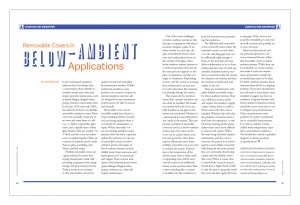Removable Covers in Below-Ambient Applications
In the mechanical insulation industry there has always been a conversation about whether to insulate certain items that may require periodic maintenance, such as paired flanges, flanged valves, pumps, strainers, and similar items. In the late 1970s and early 1980s, the industry started to use flexible removable insulation covers. These covers are normally composed of an inner and outer layer of a silicon- or Teflon-coated fiber glass mesh, and a middle layer or fiber glass blanket. They are usually 1” to 2” thick and the covers are either sewn or stapled together. There are a variety of methods used to hold them in place, including, wire, Velcro, and belt straps.
Flexible removable covers are a great solution for items that require maintenance while still providing companies with energy savings and personnel protection. Today’s products are resistant to dirt and weather and can be easily removed and reinstalled by maintenance workers. Unlike traditional insulation, some products are created to require no special insulation expertise and are designed for any maintenance professional to be able to remove and reinstall.
Removable covers can be incredibly useful since there is a long-standing problem of insulation not being replaced when it is removed for maintenance or repair. While removable covers are certainly useful for many systems, there has been a question within the industry as to the use of removable covers on below-ambient systems. Examples of below-ambient systems include chilled water, brine, ammonia, and liquid gasses such as natural gas and oxygen. These systems have many of the aforementioned items (paired flanges, flanged valves, pumps, strainers, etc.) that will require maintenance.
One of the main challenges on below-ambient systems is that the pipe or equipment will attract moisture. Imagine a glass of ice water outside on a hot day: the glass immediately attracts moisture, and condensation forms on the outside of the glass. Since below-ambient systems operate at a colder temperature than the air, the same process happens on the pipe or equipment, and they can begin to condensate. Depending on how cold the system is running, that condensation can turn into ice. Left unchecked, this moisture can severely damage the system.
This propensity for moisture means that a proper insulation system must be installed. The insulation system will need to be carefully installed so any gaps in the system are minimized. Moisture is a determined foe and will look for any cracks in the system. This may present a problem if removable covers are used in a below-ambient system, since the seams on the cover can be a place where moisture may penetrate. Also, there may be additional seams where multiple removable covers are used to insulate the system.
Depending on the temperature of the system, many times a butyl caulk or expanding foam will be used over the seams as an additional barrier to the moisture draw. Then, a vapor retarding film or mastic is installed over the insulation to keep the moisture from penetrating the insulation.
The difficulty with removable covers is that the seams where the materials connect to each other or to the attaching pipe may not be sufficiently tight enough to keep out the moisture and may allow condensation or ice to form underneath the cover. As with any installed insulation system, once there is moisture inside the system, the situation can worsen, and here the moisture is held inside and unable to dry out.
There are manufacturers who make flexible removable covers for below-ambient systems. They use a different exterior jacket and require the installer to apply a layer of latex foam or caulk to all the seams after the cover is installed. Whether this will solve the problem of moisture draw, I don’t have the experience to say. However, foaming all the seams makes them much more difficult to remove and replace. When the item being insulated requires maintenance and the cover is removed, the person now removing the cover is likely concerned with fixing the mechanical problem, not necessarily about being careful with the flexible removable cover. When it comes time to reinstall the cover, the person should have a higher level of skill to take the time to properly install the cover and then apply the foam to any gaps. If the cover is not properly reinstalled, you may end up with moisture and possibly ice, or even corrosion.
Based on these factors and my personal experience, I do not recommend the use of flexible removable covers on below-ambient systems. While they can be invaluable on certain systems and make it easier for maintenance personnel to install and re-install, they may not be ideal for below-ambient systems where moisture draw will be an ongoing problem. If you have decided that you still want to have these covers installed, I suggest you have an insulation company familiar with below-ambient insulation systems install the covers every time to try to mitigate any potential issues. Other manufacturers make
products for indoor commercial use in controlled environments. It is vital to evaluate 3 items: chilled water temperature, vapor drive, and ambient conditions. You should also consult a qualified engineer to discuss products or specifications.
Copyright Statement
This article was published in the February 2019 issue of Insulation Outlook magazine. Copyright © 2019 National Insulation Association. All rights reserved. The contents of this website and Insulation Outlook magazine may not be reproduced in any means, in whole or in part, without the prior written permission of the publisher and NIA. Any unauthorized duplication is strictly prohibited and would violate NIA’s copyright and may violate other copyright agreements that NIA has with authors and partners. Contact publisher@insulation.org to reprint or reproduce this content.

